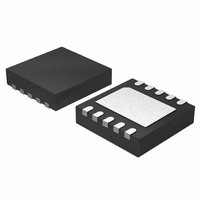ATTINY13V-10MMU Atmel, ATTINY13V-10MMU Datasheet - Page 27

ATTINY13V-10MMU
Manufacturer Part Number
ATTINY13V-10MMU
Description
MCU AVR 1K ISP FLASH 1.8V 10-QFN
Manufacturer
Atmel
Series
AVR® ATtinyr
Specifications of ATTINY13V-10MMU
Core Processor
AVR
Core Size
8-Bit
Speed
10MHz
Peripherals
Brown-out Detect/Reset, POR, PWM, WDT
Number Of I /o
6
Program Memory Size
1KB (512 x 16)
Program Memory Type
FLASH
Eeprom Size
64 x 8
Ram Size
64 x 8
Voltage - Supply (vcc/vdd)
1.8 V ~ 5.5 V
Data Converters
A/D 4x10b
Oscillator Type
Internal
Operating Temperature
-40°C ~ 85°C
Package / Case
10-MLF®, 10-DFN
Processor Series
ATTINY1x
Core
AVR8
Data Bus Width
8 bit
Data Ram Size
64 B
Interface Type
SPI
Maximum Clock Frequency
10 MHz
Number Of Programmable I/os
6
Number Of Timers
1
Maximum Operating Temperature
+ 85 C
Mounting Style
SMD/SMT
Minimum Operating Temperature
- 40 C
On-chip Adc
10 bit, 4 Channel
Package
10MLF EP
Device Core
AVR
Family Name
ATtiny
Maximum Speed
10 MHz
Operating Supply Voltage
2.5|3.3|5 V
For Use With
ATSTK600 - DEV KIT FOR AVR/AVR32770-1007 - ISP 4PORT ATMEL AVR MCU SPI/JTAGATAVRDRAGON - KIT DRAGON 32KB FLASH MEM AVRATAVRISP2 - PROGRAMMER AVR IN SYSTEMATJTAGICE2 - AVR ON-CHIP D-BUG SYSTEM
Lead Free Status / RoHS Status
Lead free / RoHS Compliant
Connectivity
-
Lead Free Status / Rohs Status
Details
6.4
6.4.1
2535J–AVR–08/10
Register Description
OSCCAL – Oscillator Calibration Register
The ripple counter that implements the prescaler runs at the frequency of the undivided clock,
which may be faster than the CPU’s clock frequency. Hence, it is not possible to determine the
state of the prescaler – even if it were readable, and the exact time it takes to switch from one
clock division to another cannot be exactly predicted.
From the time the CLKPS values are written, it takes between T1 + T2 and T1 + 2*T2 before the
new clock frequency is active. In this interval, 2 active clock edges are produced. Here, T1 is the
previous clock period, and T2 is the period corresponding to the new prescaler setting.
• Bit 7 – Res: Reserved Bit
This bit is reserved bit in ATtiny13 and it will always read zero.
• Bits 6:0 – CAL[6:0]: Oscillator Calibration Value
Writing the calibration byte to this address will trim the internal Oscillator to remove process vari-
ations from the Oscillator frequency. This is done automatically during Chip Reset. When
OSCCAL is zero, the lowest available frequency is chosen. Writing non-zero values to this regis-
ter will increase the frequency of the internal Oscillator. Writing 0x7F to the register gives the
highest available frequency.
The calibrated Oscillator is used to time EEPROM and Flash access. If EEPROM or Flash is
written, do not calibrate to more than 10% above the nominal frequency. Otherwise, the
EEPROM or Flash write may fail. Note that the Oscillator is intended for calibration to 9.6 MHz or
4.8 MHz. Tuning to other values is not guaranteed, as indicated in
To ensure stable operation of the MCU the calibration value should be changed in small steps. A
variation in frequency of more than 2% from one cycle to the next can lead to unpredicatble
behavior. Changes in OSCCAL should not exceed 0x20 for each calibration. It is required to
ensure that the MCU is kept in Reset during such changes in the clock frequency
Table 6-7.
Bit
Read/Write
Initial Value
OSCCAL Value
0x00
0x3F
0x7F
Internal RC Oscillator Frequency Range
R
7
–
0
with Respect to Nominal Frequency
CAL6
R/W
Typical Lowest Frequency
6
CAL5
R/W
5
100%
50%
75%
Device Specific Calibration Value
CAL4
R/W
4
CAL3
R/W
3
with Respect to Nominal Frequency
CAL2
R/W
2
Typical Highest Frequency
Table 6-7
CAL1
R/W
1
100%
150%
200%
below.
CAL0
R/W
0
OSCCAL
27
















